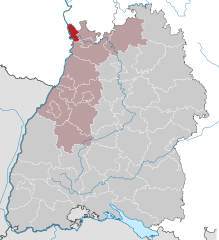Mannheim
| Mannheim | |
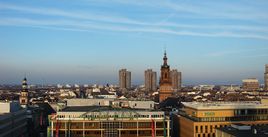 |
|
 |
|
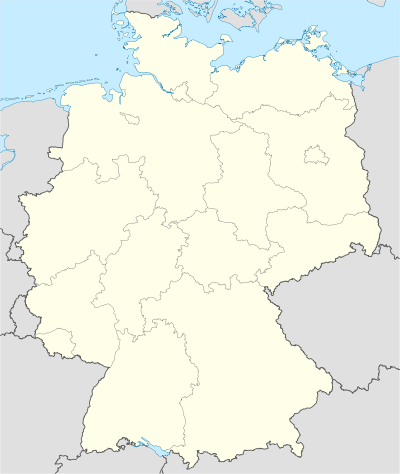 Mannheim
|
|
|
Location of Mannheim in Baden-Württemberg
|
|
|---|---|
| Coordinates | |
| Administration | |
| Country | Germany |
| State | Baden-Württemberg |
| Admin. region | Karlsruhe |
| District | Urban district |
| Lord Mayor | Peter Kurz (SPD) |
| Basic statistics | |
| Area | 144.96 km2 (55.97 sq mi) |
| Elevation | 97 m (318 ft) |
| Population | 311,969 (31 December 2009)[1] |
| - Density | 2,152 /km2 (5,574 /sq mi) |
| Other information | |
| Time zone | CET/CEST (UTC+1/+2) |
| Licence plate | MA |
| Postal codes | 68001–68309 |
| Area code | 0621 |
| Website | www.mannheim.de |

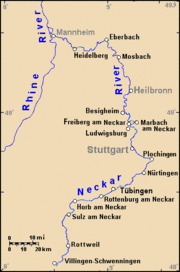
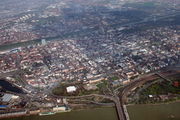
Mannheim is a city in southwestern Germany. With about 311,350 inhabitants, Mannheim is the second-largest city in the Bundesland of Baden-Württemberg, following the capital city of Stuttgart.
Mannheim is located at the confluence of the Rhine River and the Neckar River in the northwestern corner of Baden-Württemberg. The Rhine separates Mannheim from the city of Ludwigshafen, just to the west of it in Rhineland-Palatinate. The border of Baden-Württemberg with the Bundesland of Hesse is just north of Mannheim, and Mannheim is just downstream along the Neckar from the city of Heidelberg. Mannheim is the largest city of the Rhine Neckar Area, a metropolitan area with about 2.4 million inhabitants.
Mannheim is rather unusual among German cities in that the streets and avenues of Mannheim's central area are laid out in a grid pattern, just like most North American and Australian cities and towns are. Because of this, the city's nickname is "die Quadratestadt" (the German word for "city of the squares"). One main route through the streets and avenues runs by a large 18th Century palace, the Mannheim Palace. This former home of the rulers of the Palatinate now houses part of the University of Mannheim.
The civic symbol of Mannheim is der Wasserturm (the water tower), an old tower that is located just east of the city's center.
Mannheim is also the location of both the start and the finish of Bertha Benz Memorial Route.
Contents |
History
"Mannenheim" ("Home of Manno") is first mentioned in connection with a legal transaction in the year 766, in the "Codex Laureshamensis" from Lorsch Abbey. Mannheim remained a mere village until Frederick IV, Elector Palatine started building the fortress of Friedrichsburg and the adjacent city center (die Stadt) in 1606 - with its grid of streets and avenues. On January 24, 1607, Frederick IV gave Mannheim the status of a "city", whether it really was one by then or not.
Mannheim was mostly leveled during the Thirty Years War in about 1622 by Johan Tilly's troops, and once again during the Nine Years War in 1689 by the French Army.
After the rebuilding of Mannheim that began in 1698, the capital of the Electoral Palatinate was moved from Heidelberg to Mannheim in 1720. This was when Karl III Philip, Elector Palatine began the construction of the Mannheim Palace and the Jesuit Church. These were completed in the year 1760.
During the 18th Century, Mannheim was the home of the "Mannheim School" of classical music composers. Mannheim was said to have one of the best court orchestras in Europe under the leadership of the conductor Carlo Grua. The royal court of the Palatinate left Mannheim in 1778, and just over two decades later, Mannheim was removed from the Palatinate and given to the Grand Duchy of Baden (in 1802).
In 1819, Norwich Duff made the following observations about Mannheim:
Mannheim is in the Duchy of Baden and situated at the confluence of the Rhine and Neckar over both of which there is a bridge of boats. This is the third town of this name having been twice burnt. The houses are large, and the streets broad and at right angles to each other, and is one of the most airy clean towns I have seen in Germany. It was formerly fortified, but the fortifications were rased in 1806 and gardens fill their places. There is a large Chateau here belonging to the Grand Duke and a very good garden; part of the Chateau was destroyed when the town was bombarded and has never since been repaired, the other part is occupied by the Grand Duchess widow of the late Grand Duke who was succeeded by his Uncle having left only three daughters. She is the sister of Eugene Beauharnais [sic, she was in fact his second cousin]. There is a Cathedral, a Theatre which is considered good, an observatory, a gallery of pictures at the Chateau, and some private collections. About two km (one mile) below the town the Russian Army crossed the Rhine in 1813. Population 18 300.
Inventions
Some important inventions were made in Mannheim.
- Karl Drais built the first two-wheeled draisine in 1817.
- Karl Benz' first car appeared on the streets of Mannheim in 1886. At his workshop in Mannheim he produced a lightweight three-wheeled vehicle powered by a single cylinder petrol/gasoline-fueled engine, first shown in public around 1886. This powered tricycle subsequently came to be widely regarded as the original automobile/motor car.
- The Lanz Bulldog, a popular tractor with a rugged, simple Diesel engine was introduced in 1921.
- Julius Hatry built the world's first rocket plane in 1929.
 The world’s first bicycle, built in Mannheim by Karl Freiherr von Drais in 1817 |
 The world’s first automobile, built in Mannheim by Karl Benz in 1885 |
Official sign of Bertha Benz Memorial Route, commemorating the world's first long distance journey by automobile from Mannheim to Pforzheim in 1888 (104 km / 64 miles) |
World War II
During World War II, since Mannheim was an important industrial center for Nazi Germany, Mannheim was heavily damaged by aerial bombing by the Royal Air Force (R.A.F.) and the U.S. Army Air Forces. Besides bombing the important factories, the R.A.F. razed the city center of Mannheim with nighttime area bombing.
Some sources state that the first deliberate "terror bombing" of German civilians by the R.A.F. occurred at Mannheim on December 16, 1940. [2]
Mannheim was overrun by the U.S. Third Army on March 29, 1945, and removed from the control of Nazi Germany . There has been a large American military presence in the Mannheim area ever since (see United States military installations below).
In 2007, Mannheim celebrated its 400th birthday with a series of cultural and other events spread over the whole year. The 400th birthday proper was in 2006, since Frederick IV, Elector Palatine laid the foundations of the Mannheim citadel, on March 17, 1606.
Theatre
The "Nationaltheater Mannheim" was founded in 1779 and is the oldest "Stage" in Germany. In 1782 the premier of "Die Räuber" written by Friedrich Schiller was shown.
Climate
| Climate data for Mannheim, Germany | |||||||||||||
|---|---|---|---|---|---|---|---|---|---|---|---|---|---|
| Month | Jan | Feb | Mar | Apr | May | Jun | Jul | Aug | Sep | Oct | Nov | Dec | Year |
| Average high °C (°F) | 3 (37) |
5 (41) |
10 (50) |
14 (57) |
19 (66) |
22 (72) |
25 (77) |
24 (75) |
20 (68) |
14 (57) |
7 (45) |
5 (41) |
14 (57) |
| Average low °C (°F) | 0 (32) |
2 (36) |
3 (37) |
5 (41) |
10 (50) |
13 (55) |
15 (59) |
15 (59) |
11 (52) |
7 (45) |
3 (37) |
1 (34) |
7 (45) |
| Precipitation cm (inches) | 2 (0.8) |
2 (0.8) |
2 (0.8) |
3 (1.2) |
7 (2.8) |
6 (2.4) |
6 (2.4) |
4 (1.6) |
4 (1.6) |
3 (1.2) |
4 (1.6) |
4 (1.6) |
55 (21.7) |
| Source: Weatherbase[3] | |||||||||||||
Mannheim is located in Germany's warmest region, the "Rhine shift". In summer, temperatures sometimes rise up to 35 C° and higher. The highest recorded temperature was 41 C° during the 2003 European heat wave. The daily lows during that time were also very high (around 25 C°). In comparison to other regions of Germany, Mannheim has a higher humidity in summer which causes a higher heat index. Snow is rare, even in the cold months. Precipitation occurs mostly during afternoon thunderstorms during the warmer period (average days of thunderstorms in a year is 40-50).
Main sites to see
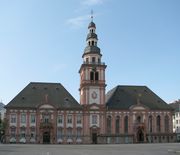



- Fernmeldeturm Mannheim
- Yavuz Sultan Selim Mosque
- Luisenpark - named one of the most beautiful parks of Europe
- Pylon test facility Mannheim
- Mannheim Palace (Mannheimer Schloss) - the city castle and main building of the University of Mannheim
- Wasserturm - the town's landmark water tower
- Jesuit Church
- SAP Arena - multifunctional Stadium, home of the Mannheim Ice-hockey Team "Die Adler", which means "The Eagles."
- Breite Strasse, Kunststrasse, and Kapuzinerplanken - Mannheim's main shopping destination
- International Filmfestival Mannheim-Heidelberg
- Wildpark and Waldvogelpark am Karlstern
- The city centre, designed in squares (Quadratestadt)
- Reißinsel, a natural area that an honorary citizen of Mannheim, Carl Reiß, bequeathed to the inhabitants of Mannheim
- Marktplatz (Market place), this is the square where fresh farmer's market takes place every Monday and Wednesday. Fresh fruits, vegetables, and flowers can be purchased.
- "Café Samo", a cafe in town frequented by college students where one can have good-quality coffee for a reasonable price. Located at Paradeplatz, on the way to Schloss Mannheim
Industry
The successor to the Karl Benz automobile manufacturing companies begun in Mannheim, Daimler AG has had a large presence in Mannheim. Today, diesel engines and buses are assembled there. The Swiss Roche Diagnostic group (formerly known as Boehringer Mannheim) has its division headquarters in Mannheim. Additionally, the city also hosts large factories and offices of ABB, Alstom, BASF (Ludwigshafen), Bilfinger Berger, Bombardier, Fuchs Petrolub AG, John Deere, Siemens, SCA, Südzucker and other companies.
U.S. Army locations
A number of U.S. Army Europe installations are located in and near Mannheim. The following locations provide services to and house the "U.S. Army Garrison Mannheim", and the U.S. Army everywhere in Europe.
- The Benjamin Franklin Village (Mannheim-Käfertal), housing. Also, it is the home of the Mannheim American High School and the Middle School [1].
- Coleman Barracks and Coleman Army Airfield (Mannheim-Schönau) (The headquarters of the American Forces Network-Europe, and the home of the Army's 28th Transportation Battalion. Also, the location of the "U.S. Army Confinement Facility Europe"
- Funari Barracks (Mannheim-Käfertal)
- Spinelli Barracks (Mannheim-Feudenheim)
- Sullivan Barracks (Mannheim-Käfertal) - the headquarters of the U.S. Army's 7th Signal Brigade.
- Taylor Barracks (Mannheim-Vogelstang) - the headquarters of the U.S. Army's 2nd Signal Brigade
The following locations are part of the "U.S. Army Garrison Heidelberg" but are within the area of the city of Mannheim:
- Friedrichsfeld Service Center (Mannheim-Friedrichsfeld)
- Hammonds Barracks (Mannheim-Seckenheim)
- Stem Kaserne (Mannheim-Seckenheim)
The long-term future of the U.S. Army military community at Mannheim is in doubt since it was not included in the announcement by the U.S. Army Europe in 2004 of those military units that would remain following a long-term restructuring and downsizing of American armed forces in Europe. The U.S. Army has already closed several installations in Mannheim - the Rhine River Patrol compound in Sandhofen (1958), the Gendarmerie Kaserne in Schönau, the NATO bunker (?) in Feudenheim, and the Turley Barracks in Wohlgelegen.
Transportation
Roads

The Mannheim/Ludwigshafen area is surrounded by a ring of motorways connecting it to Frankfurt in the north, Karlsruhe in the south, Saarbrücken in the west and Nürnberg in the east.
Railway
Mannheim Hauptbahnhof (central station) is at the end of the Mannheim-Stuttgart high-speed rail line and is the most important railway junction in the southwest of Germany, served by ICE high-speed train system with connections to Frankfurt am Main / Berlin, Karlsruhe / Basel and Stuttgart / Munich. A new high speed line to Frankfurt is also planned to relieve the existing Ried Railway (Riedbahn). Mannheim Harbour is the second largest river port in Germany.
Airports
Although Frankfurt International Airport is only 65 km north, since 2004 there have been daily passenger flights from Mannheim City Airport (IATA code MHG) to Berlin, Hamburg and Saarbrücken.
Local Public Transport
Local public transport in Mannheim includes the RheinNeckar S-Bahn, eleven tram lines and numerous bus lines operated by Rhein-Neckar-Verkehr (Rhine-Neckar transport).
The RheinNeckar S-Bahn, established in 2003, connects most of the Rhine-Neckar area including lines into the Palatinate, Odenwald and southern Hesse. All S-Bahn lines run through Mannheim Hauptbahnhof, except S5. Further S-Bahn stations are at present Mannheim-Rangierbahnhof, Mannheim-Seckenheim and Mannheim-Friedrichsfeld-Süd.
Metre-gauge trams are operated in Mannheim, Ludwigshafen and Heidelberg by Rhein-Neckar-Verkehr GmbH (RNV), a company wholly owned by the three cities mentioned and a couple of municipalities in the Palatinate. RNV is the result of a merger on 1 October 2009 between the region's five former municipal transportation companies.[4] Interurban trams are operated by RNV on a triangular route between Mannheim, Heidelberg and Weinheim, and the company also operates interurban trams between Bad Dürkheim, Ludwigshafen and Mannheim. In the 1970s a proposal to build a U-Bahn out of the Mannheim and Ludwigshafen tramways was begun, but only small sections were in fact built due to lack of funds. The only underground station in Mannheim is the Haltestelle Dalbergstraße. U-Bahn planning has now stopped. All public transport is offered at uniform prices set by the Verkehrsverbund Rhein-Neckar (Rhine-Neckar transport union, VRN).
Sport

The football Bundesliga club TSG 1899 Hoffenheim was based in Mannheim's Carl-Benz-Stadion from July until December 2008 (until the completion of its new stadium, the Rhein-Neckar-Arena in Sinsheim), as is the 4th-division club SV Waldhof Mannheim.
The Adler Mannheim is an ice hockey team playing (formerly MERC, Mannheimer Eis- und Rollsport-Club) in the professional Deutsche Eishockey Liga, having won the championship six times.
The Rhein-Neckar-Loewen (Rhine-Neckar-Lions) is a Handball team (formerly SG Kronau-Oestringen) playing in the professional German Handball League.
The WWE visited Mannheim in 2008 and grossed over half a million dollars with over 6500 fans attending the event.
Mannheim hosted the 2007 European Show Jumping Championships[5] 14–19 August, in the MVV-riding stadium. This is second time the city has hosted it, it previously held the championships in 1997.
International relations
Mannheim is twinned with:
 Bydgoszcz, Poland
Bydgoszcz, Poland Chişinău, Moldova
Chişinău, Moldova Haifa, Israel
Haifa, Israel Klaipėda, Lithuania
Klaipėda, Lithuania
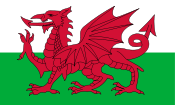 Swansea, Wales, United Kingdom
Swansea, Wales, United Kingdom Toulon, France
Toulon, France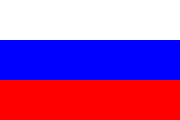 Ulan Ude, Russia
Ulan Ude, Russia Windsor, Canada
Windsor, Canada Zhenjiang, China
Zhenjiang, China
Famous people from Mannheim
- 1762: Constanze Mozart, wife of Wolfgang Amadeus Mozart (1756–1791)
- 1821: Friedrich Engelhorn, founder of BASF
- 1856: Henry Morgenthau, Sr., United States politician and manager
- 1897: Sepp Herberger, coach of the German national soccer team from 1936-64 ("The Miracle of Bern", world champion with his team in 1954)
- 1905: Albert Speer, Nazi architect, Minister for Armaments and Munitions during World War II
- 1939: Christiane Schmidtmer, Hollywood actress
- 1946: Fred Breinersdorfer, writer
- 1960: Norbert Schwefel, musician
- 1969: Steffi Graf, tennis player
- 1971: Xavier Naidoo, pop singer
- 1972: Christian Wörns, football player for Borussia Dortmund and formerly Germany
- 1977: Jochen Hecht, Buffalo Sabre National Hockey League
- See also: Famous people from Mannheim (German)
References
- ↑ "Bevölkerung und Erwerbstätigkeit" (in German). Statistisches Landesamt Baden-Württemberg. 31 December 2009. http://www.statistik.baden-wuerttemberg.de/Veroeffentl/Statistische_Berichte/3126_09001.pdf.
- ↑ http://books.google.com/books?id=8J2-kzMxbKYC&pg=PA507&dq=%22Germany+and+the+Second+World+War%22+%22deliberate+terror%22+Mannheim&as_brr=3&sig=bFzGao4uHyptBHQTiDx0y1DzXWg
- ↑ Weatherbase: Historical Weather for Mannheim, Germany. Weatherbase. 2007. http://www.weatherbase.com/weather/weather.php3?s=82701&refer=&units=metric. Retrieved 2007-02-04.
- ↑ "Press release announcing the merger to form RNV (German-language)". of 23 September 2009. http://www.rnv-online.de/rnvGips/Gips;jsessionid=D599A53604ABB5F1D24D663A7F42FD3C?SessionMandant=RNV&Anwendung=CMSTickerEintrag&Methode=ShowHTMLAusgabe&SessionMandant=&RessourceID=56833. Retrieved 2009-10-06.
- ↑ FEI European Jumping Championship, Mannheim
External links
- Official page of Mannheim
- Mannheim travel guide from Wikitravel
- Rhein-Neckar Metropoliten Region Visitors' Site
- Verkehrsverbund Rhein-Neckar (Rhine-Neckar Transport)
- Gourmet Guide Mannheim
- Parks in Mannheim
- Bertha Benz Memorial Route
- 504th Signal Battalion Photos and maps of Benjamin Franklin Village (Käfertal), Sullivan Barracks (Käfertal)and the Mannheim Military Community in the 1960s
- U.S. Army Garrison Mannheim homepage
|
||||||||||||||
|
||||||||||||||
|
||||||||
